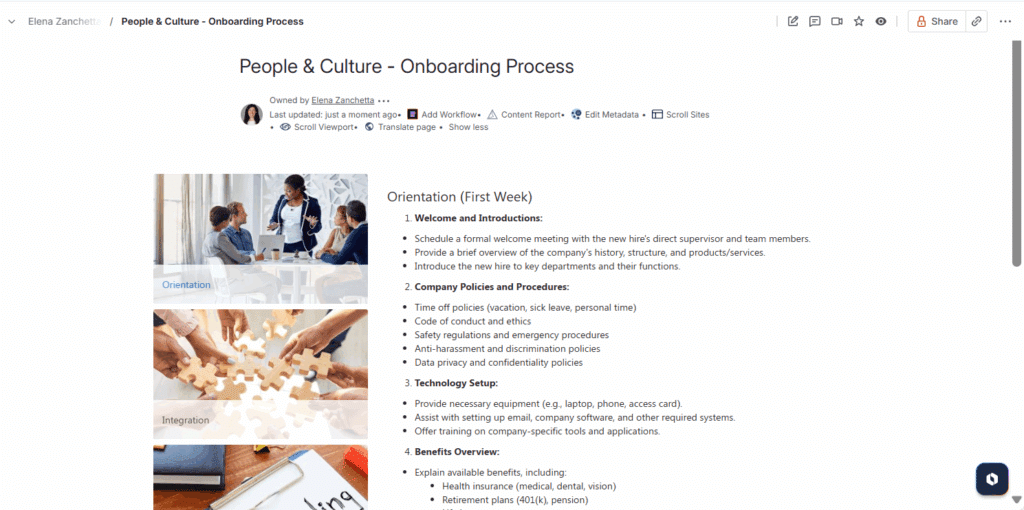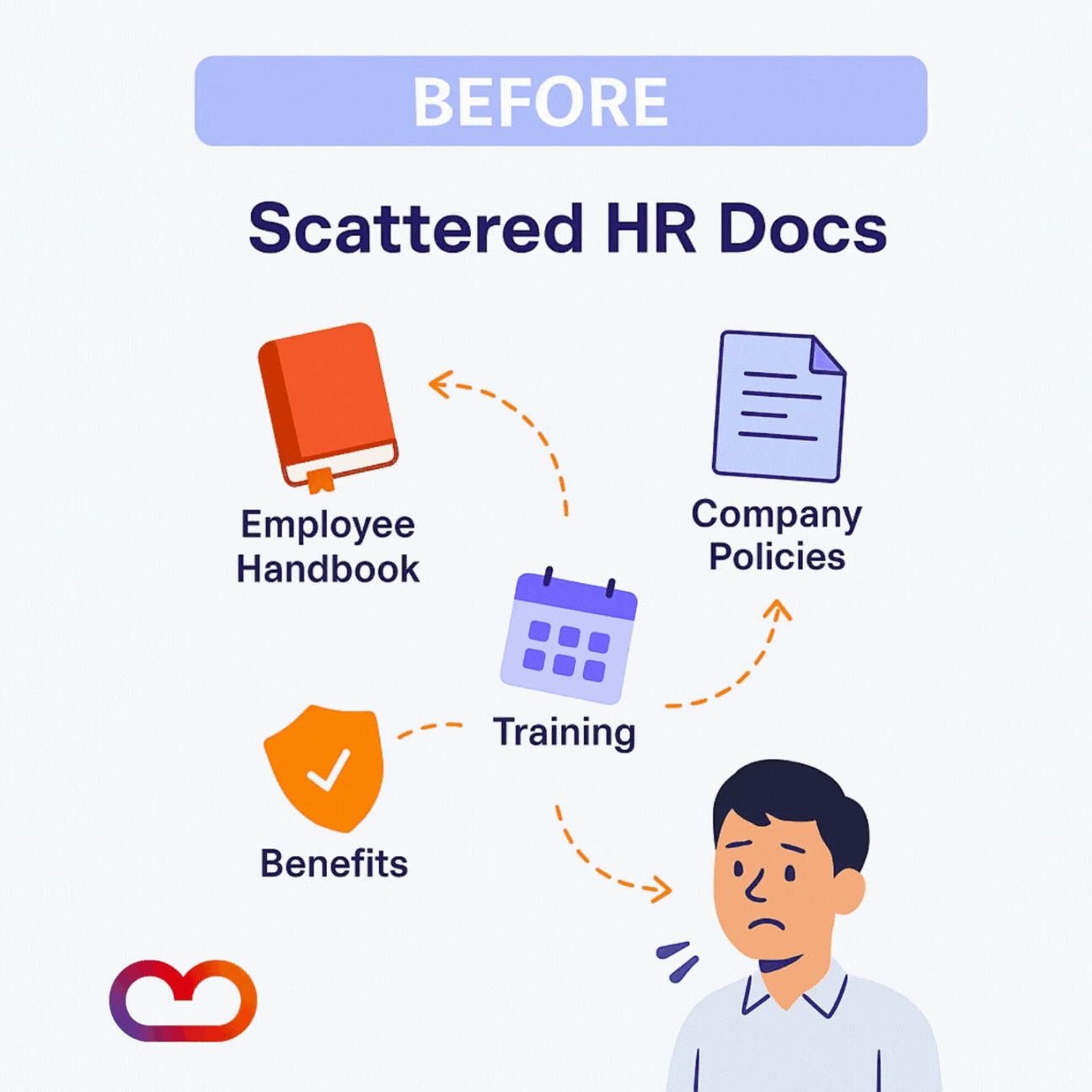Community resources
Community resources
Community resources
Why Centralized HR Documentation Matters for Onboarding
Hi community 👋
I’m Elena from Communardo Products, and today I want to share a little story that might sound all too relatable.
On his first day, John logs into Confluence, eager to learn about his new company. Within minutes, excitement turns into confusion. The employee handbook is in one space, benefits details are in another, and training schedules are hidden in a PDF from last year. After 20 minutes of searching, John gives up and messages HR: “Hey, where can I find the onboarding materials?”
Sound familiar?
This is the everyday reality for new hires in many enterprises. Scattered HR documentation makes onboarding slow, frustrating, and inefficient. HR teams get buried under repetitive questions, while employees waste valuable time hunting down basic information.
With Confluence Cloud and the right structure, this doesn’t have to happen. By centralizing HR documentation into a single hub, you can transform onboarding from overwhelming to effortless.
A Releatable Scenario: Meet Alex, Jamie, and John
To bring this challenge to life, let’s follow three key players:
- Alex, the HR Manager, is tired of answering the same onboarding questions over and over.
- Jamie, the Knowledge Manager, feels overwhelmed trying to keep scattered Confluence pages organized.
- John, the new employee, wants to find the training schedule and benefits details without pinging HR every time.
When these three needs collide, onboarding quickly becomes frustrating. The good news? There’s a simple fix.
The Challenge: Scattered HR Resources
In many companies, onboarding documents are spread across Confluence like puzzle pieces with no picture on the box.
The employee handbook lives in one space. Policies sit on another page. Training schedules hide in a PDF that no one updates. Benefits information is tucked away somewhere else entirely.
Without a central hub, new hires bounce between links, unsure whether what they’ve found is accurate or current. HR ends up answering the same questions repeatedly, and knowledge managers waste time duplicating or cleaning up content.
The Solution: A Single HR Documentation Landing Page
Now, picture a different scenario. Instead of chasing documents across spaces, John opens a single Confluence page: HR Documentation Hub. Everything he needs is right there, neatly organized into labeled tabs.
Here’s how Jamie sets it up with the Navitabs Tab Wizard in Confluence Cloud:
- First, she audits existing onboarding content: policies, training, handbook, benefits.
- Next, she builds tabs such as Employee Handbook, Training, Company Policies, and Benefits. Each tab automatically pulls in pages by label—no copy-paste required.
- Alex reviews the content for accuracy and completeness.
- The link to this landing page is shared in welcome emails, onboarding checklists, and intranet menus.
- When John logs in, he clicks the tab he needs, and the information is there.
And for teams who want an even more engaging look, Navitabs Cloud also supports Cards, which transform the landing page into a visually appealing grid of clickable sections. This not only makes onboarding resources easier to scan but also gives HR documentation a polished, modern feel.

The Benefits of Centralized HR Documentation
Everyone wins when onboarding is simplified.
- For Alex, the HR Manager: fewer repetitive queries and more time for strategic work.
- For Jamie, the Knowledge Manager: a structured hub that’s easy to update and maintain.
- For John, the new employee: quick access to accurate resources, without confusion or delays.
- For the company: faster onboarding, improved satisfaction, and more efficient HR operations.
Instead of wasting energy navigating Confluence, new hires can focus on learning, engaging, and contributing.

Why Confluence Cloud and Navitabs Work So Well Together
Confluence is already a powerful tool for enterprise knowledge management, but without structure, it can become a maze. Navitabs fixes that by adding a clean, intuitive layer of navigation.
Tabs allow you to group related content logically, while Cards add a visual layout that feels less like a document dump and more like a digital welcome kit. Together, they give HR teams the flexibility to present information in the way employees actually want to consume it.
Tips for Getting Started
If you’re ready to centralize HR documentation, keep these best practices in mind:
- Use consistent labels so content automatically appears in the right tabs.
- Keep pages short and scannable; break down long PDFs into digestible sections.
- Review content quarterly to ensure policies and benefits are up to date.
- Promote the HR hub proactively through welcome emails, chat channels, and onboarding checklists.
- Ask new hires for feedback to refine navigation and clarity.
Small steps like these can make a big difference in creating a frictionless onboarding journey.
Building a Culture of Accessibility
Centralizing HR documentation isn’t just an operational tweak—it sends a cultural message. It shows new employees that the company values their time, respects their need for clarity, and invests in their success.
When HR teams reduce friction, they free up space to focus on people, not paperwork. Knowledge managers can shift from patching pages to improving content strategy. And new hires feel informed and supported, not lost in a maze of links.
Final Thoughts
Onboarding is the first real impression employees get of your organization’s culture. If documents are scattered, links are outdated, and answers are hard to find, the message is clear: inefficiency rules here.
But when you create a centralized HR documentation hub in Confluence with Navitabs, the opposite is true. Employees feel empowered, HR teams feel efficient, and the company as a whole benefits from smoother, faster onboarding.
The first days matter most—make them count with centralized HR documentation.
Was this helpful?
Thanks!
Elena_Communardo Products
About this author
Product Marketing Manager
Communardo
Austria
6 accepted answers
0 comments